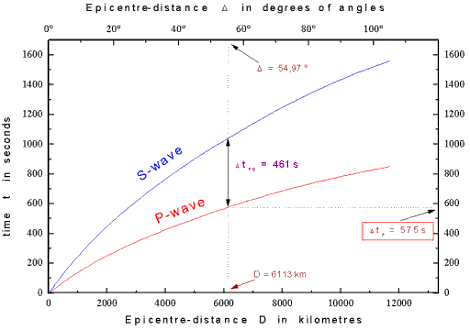6.1 Epicentre-distance and origin time
The first step we take when evaluating a seismogram is the fixing of the distance from our seismographic station to the epicentre and the calculation of the origin time, i.e. the time when the earthquake really happened. For this purpose we need the time-interval between the arrivals of the P-Wave and the S-Wave. We pick up that information from of the North-South - seismogram : for the Ascension-Earthquake this means ΔtPS = 461 s.
For many years seismologists have empirically determined the values of the travel-times of various earthquake-waves: this means the running time of the corresponding signals from the epicentre to the station. This work was done for as many distances as possible and for many types of waves: here we need the travel-times of P- and S-waves. The measurements are summed up in the following "travel-time diagram".
Pick up the interval Dt PS from the seismogram and fit it in between the travel-time curves of P- and S-wave: from this unequivocal position you can fix the epicentre-distance by drawing a line perpendicular to the lower axis: here the epicentre-distance Δ is almost 55 °, i.e. about 6100 km.
The horizontal line from the fitting point at the P-wave to the left axis supplies us with the travel-time of the first signal from the epicentre to the station: here that travel time amounts to ΔtP = 575 s or 9 minutes and 35 seconds.
The P-wave of the Ascension-Earthquake arrived at Monschau at 23.59h and 2 seconds; if you subtract the travel-time of the P-wave (9 min 35 s) from its time of arrival at Monschau you will get the time at which the earthquake began, the so-called "origin-time".
Here we therefore get for the origin-time 23.49 and 27s. The official measurement of the "National Earthquake Information Survey (NEIS)" in Golden (Colorado) differs from our origin-time in just a few tenths of seconds. The "NEIS-Data" are determined with the help of data coming from many earthquake observatories all over the world. For the Ascension-earthquake the data acquisition was done by 109 stations with at least 3 seismographs each.

